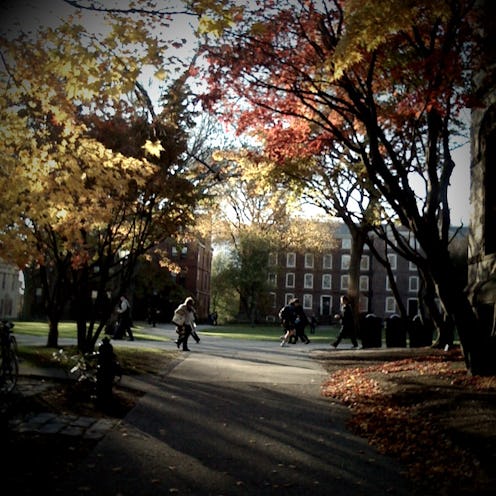
It's refreshing that even a university known for its reputation as one of the most liberal schools in America is acknowledging that racism is a big problem on its campus. Brown University's "Pathways to Diversity and Inclusion" plan just set aside $100 million to address this problem, as well as classism, sexism, and other issues of inclusion, over the next 10 years. The initiative serves as an example of how colleges across the country could become more welcoming for underprivileged students and provide a more eye-opening experience for privileged ones.
On its website, Brown has posted a working document outlining "a concrete set of actions to promote diversity and inclusion and confront the issues of racism, power, privilege, inequity, and injustice that are part of the Brown experience for so many members of our campus," President Christina Paxson writes in an accompanying letter. The site also includes a form for students, faculty, and staff to submit feedback before the plan becomes permanent.
The document reports grievances students have expressed, including exposure to racist behaviors on campus, financial demands that make it difficult for low-income students to learn, and homogenous perspectives represented in readings, listing ways the university plans to diversify its courses and population. These efforts include recruiting more minority students and faculty, hiring more women faculty in fields where they're underrepresented, and training faculty and staff, particularly within the Department of Public Safety, on cultural sensitivity and inclusion. The letter also sets a quota to double the number of "faculty from historically underrepresented groups" by the 2024-2025 school year.
Paxson's letter makes reference to a recent protest calling attention to racism at Brown, the Rhode Island School of Design, and Providence College, which added to a wave of protests against racism at colleges throughout the United States:
The plan also has been profoundly informed, and substantially improved by recent campus conversations about structural racism. The deep pain that we have heard expressed by students of color in the past weeks and months — a pain that has been affirmed by faculty and staff members who work closely with and care deeply about our students — is very real.
The pain Paxson references was voiced by students of color gathering on Brown's campus Nov. 12 and 13 to testify to the racism they claimed they had faced at school. One undergraduate described being stopped by university police officers for no reason. Another recounted finding a racist slur scrawled on her dorm room door. You can watch highlights from the protest in the video below:
As a Brown alum, I have myself experienced such problems as elitism and sexual assault on my alma mater's campus — problems which also plague many other U.S. colleges and universities. Nevertheless, I've always considered the group of students and alums known as "Brunonians" one of the most welcoming and inclusive communities I've ever been a part of. There's a grain of truth to the stereotype that we're radical hippies, and I'm proud of that. I'm also proud to see the administration trying to do better — and putting its funding to greater use than the unceasing building construction projects going on while I lived there.
At the same time, there's a darker side to the story. That protests regarding racism are taking place at colleges throughout our country prove that even our most progressive communities are still not safe spaces for people of color. We've been seeing similar protests at the University of Missouri, Ithaca College, Smith College, and Yale, to name just a few. More disturbing are the dismissive reactions from the media which protestors have received for voicing their opinions about important issues and trying to improve their schools. Slate defended Erica Christakis, a Yale lecturer who told students in an email thread about culturally insensitive Halloween costumes that it was OK to be "a little bit obnoxious… a little bit inappropriate or provocative or, yes, offensive," as a champion of "the crucial liberal tradition of free speech." And The Federalist characterized the University of Missouri's protests around a series of racist incidents on its campus as "raw power play."
Brown appears to be taking students' complaints more seriously than the media, and for that I'm grateful. Only time will tell what the long-term effects of Brown's initiative will be. However, there is one important immediate effect: the administration's document communicates to students of color that their concerns matter, rather than labelling them "social justice warriors" or "the PC police." Dismissing racial minorities' concerns as irrational or angry only furthers the injustices they're calling attention to; as such, it's enormously important that Brown has stepped up to the plate instead. Other schools would be wise to communicate the same message — that both these students and their concerns matter, and that a coming up with a plan to address them is imperative.